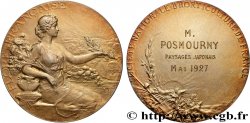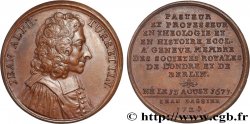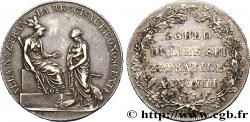You must signin and be an approved bidder to bid, LOGIN TO BID. Accounts are subject to approval and the approval process takes place within 48 hours. Do not wait until the day a sale closes to register. Clicking on "BID" constitutes acceptance of the terms of use of cgb.fr private live auctions.
Bids must be placed in whole Euro amounts only. The sale will start closing at the time stated on the item description; any bids received at the site after the closing time will not be executed. Transmission times may vary and bids could be rejected if you wait until the last second. For further information check the Live auction FAQ
All winning bids are subject to a 18% buyer’s fee.
All winning bids are subject to a 18% buyer’s fee.
| Estimate : | 200 € |
| Price : | 115 € |
| Maximum bid : | 133 € |
| End of the sale : | 10 December 2024 17:31:57 |
| bidders : | 3 bidders |
Type : Médaille pour l’emprunt à 500 millions
Date: 1859
Mint name / Town : 75 - Paris
Metal : copper
Diameter : 73,5 mm
Orientation dies : 12 h.
Engraver BOVY Antoine (1795-1877)
Weight : 208,10 g.
Edge : lisse + main CUIVRE
Puncheon : main indicatrice (1845-1860) et CUIVRE
Coments on the condition:
Belle patine marron hétérogène, présentant un joli brillant de frappe. Présence de quelques coups sur les bords de la tranche. Quelques points d’usure à l’avers
Catalogue references :
Obverse
Obverse legend : NAPOLEON III - EMPEREUR.
Obverse description : Tête nue à gauche; signé : A. BOVY.
Reverse
Reverse legend : EMPRUNT DE 500 MILLIONS // 690,230 / SOUSCRIPTEURS / - / DEUX MILLIARDS / 500 / MILLIONS // À L’EXERGUE : DECRET DU 3 MAI 1859 / M.R P. MAGNE MINISTRE / DES FINANCES.
Reverse description : Un génie vide des pièces de monnaie d’une corne d’abondance sur un autel sur lequel figure une inscription en 5 lignes. A gauche, une allégorie féminine de la France, debout, tenant à la main un enfant portant une lance en haut de laquelle une plaque porte la mention ITALIE, derrière lui un aigle impérial. Signé : A. BOVY.








 Report a mistake
Report a mistake Print the page
Print the page Share my selection
Share my selection Ask a question
Ask a question Consign / sell
Consign / sell
 Full data
Full data















